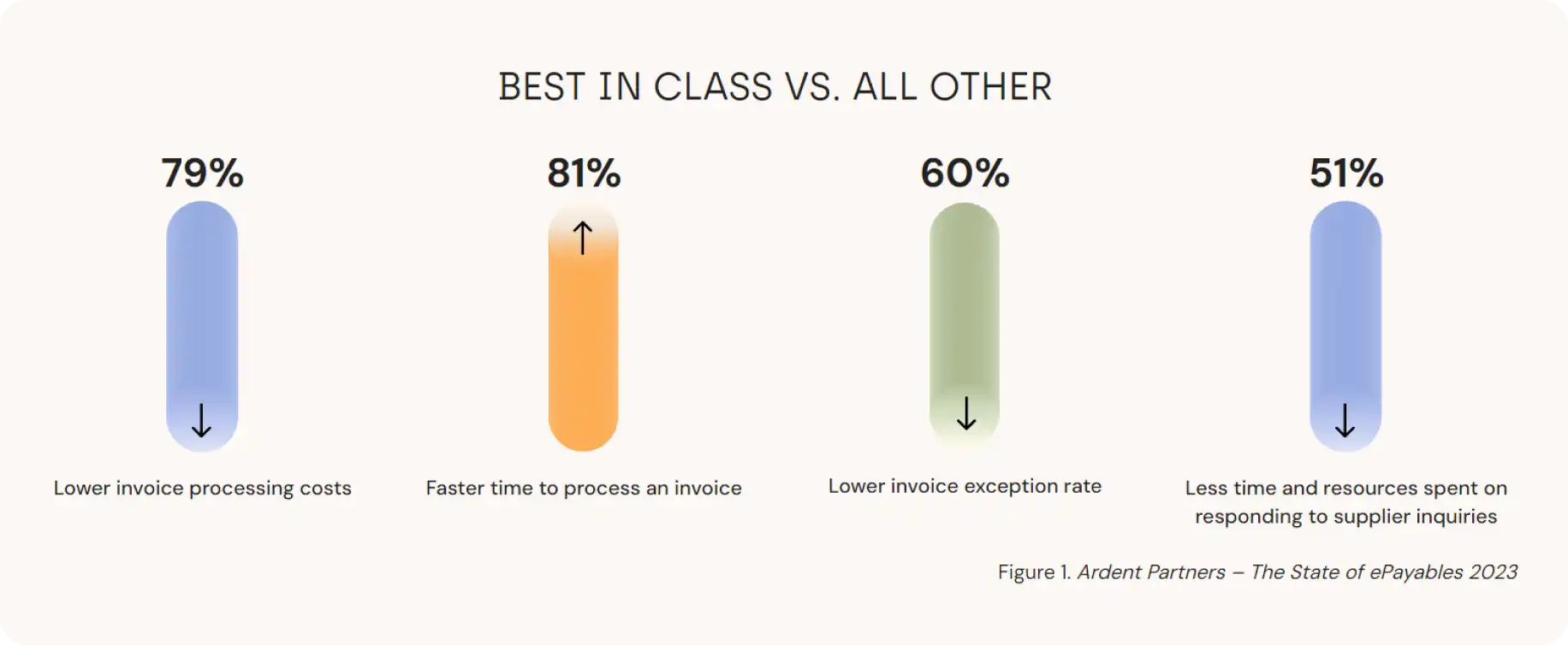Blog
The Three Horizons of AP Automation
28 Sep
Blog
28 Sep

While Accounts Payable processes may be prime candidates for process automation, it is not a priority for many firms. They see the function being strictly back-office, and conitributing to improvement of cash-outflows has little strategic value to the organization.
However, times are changing, and the topic of AP and Invoice Automation is gaining traction. Organizations worldwide are capitalizing on investing in solutions to help improve efficiencies in Accounts Payable.
The reasons are clear: best-in-class Accounts Payable can boast impressive improvements across the board: lower invoice processing costs, shorter invoice processing time, lower invoicee exception rates, highers rate of touchless processing, increased transparency and control (see figure 1).
But in order to evolve the initiative beyond improving tactical operations organizations need to have a long term plan. The end-game is a more strategic arena that provides greater value to the extended organization

Automating tactical processes in Accounts Payable is often a first step in a strategic evolution of the back-office. Starting with efficiency gains won by automation; digitizing the process builds a foundation for business intelligence. Increased efficiency releases time for elevating the role of the back office, enabling staff to focus on more strategic and value-adding tasks.
For Accounts Payable, this can involve closer collaborations with procurement, finance and treasury, supplier relationship management, as well as providing actionable intelligence for risk mitigation, cash flow management, compliance initiatives and more.
Operational excellence is achieved when technology is paired with rigid change management, well-defined KPI’s, and solid strategic planning. A holistic approach to AP and Invoice Automation drives cross-departmental benefits, as well as leads the way to increased strategic value creation.

Today, a majority of executives agree that AP Automation is of high strategic importance and provides cross-departmental benefits. A recent report by Ardent Partners indicates that more than half of organizations perceive Accounts Payable as either “very” or “exceptionally” valuable to the organization.
So how does Accounts Payable build on this gathering in strategic momentum?
Accounts Payable is uniquely positioned to provide great value to a wider organization. As a department, it touches nearly all aspects of business – from handling payment of spur-of-the-moment one-time-buys to strategic contract spend. By digitizing and automating the Accounts Payable process, the foundation is laid for an extensive data lake of financial information that can be leveraged far and beyond the traditional scope of Accounts Payable.
Keeping an eye on this end-game is essential when building the strategic plan for achieving operational excellence in Accounts Payable through automation. While most AP and Invoice Automation solutions provide rapid ROI, often in less than six months, the technology is only one piece of the puzzle.
This is where the three horizons framework comes in; it provides a great foundation for strategic development, as well as for thinking outside of the box. The three horizons framework allows an organization to bridge short-term goals (the first horizon) to long-term business evolution (the third horizon).
The first Horizon is all about picking the low-hanging fruit. In the first 6-12 Months of an AP and Invoice Automation initiative, focus should be set on centralizing Accounts Payable, setting up common processes, streamlining collaboration with procurement, and implementing an AP and Invoice Automation solution. It is very common that within this phase a 100% return on investment is achieved. Automation delivers tangible operational efficiencies such as lower invoice exception rates, faster approval cycles, and an increased degree of touchless processing. For many organizations, this is an exceptional operational improvement well worth the investment. But it also lays the foundation for AP intelligence that can be of great value to procurement, finance, as well as treasury. Which leads us to the next horizon.
The second Horizon should be focused on improving processes, implementing further tools for effectiveness, and understanding the value of the Accounts Payable data. For Accounts Payable to continue to evolve, well-defined performance indicators (KPIs) are essential. Important KPIs include: time-to-pay, average cost to process a single invoice, time-to-approve, touchless processing rates, and invoice exception rates. These common metrics not only monitor improvements in Accounts Payable but also create the foundation for actionable intelligence that can be used for supplier and spend management, risk mitigation, as well as financial and cash flow management. Accounts Payable should also enable the organization to digest this data through easy-to-access reports and agile reporting dashboards.
The final Horizon takes place around 24-48 months after the start of an AP and Invoice Automation initiative. This is where operational excellence and Accounts Payable intelligence truly can start to support strategic and financial directions in a company. At this stage, solid policies and standardized procedures support daily activities and AP staff are highly efficient and working tightly as a team.
Automation is no longer a driver, but the backbone of the AP department, delivering cross-department benefits. Vendor onboarding, invoice data capture, and remittances are common examples of completely automated tasks needing no staff effort. The efficiencies created through automation paired with the actionable intelligence captured in the Accounts Payable process allows staff to elevate their role allowing their focus to be on customer value creation rather than strictly staying in the back office executing tactical manual tasks.

Blog

Blog

Blog